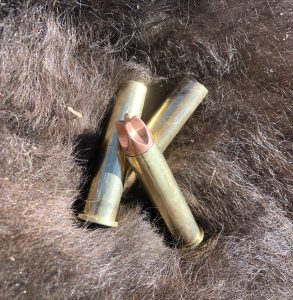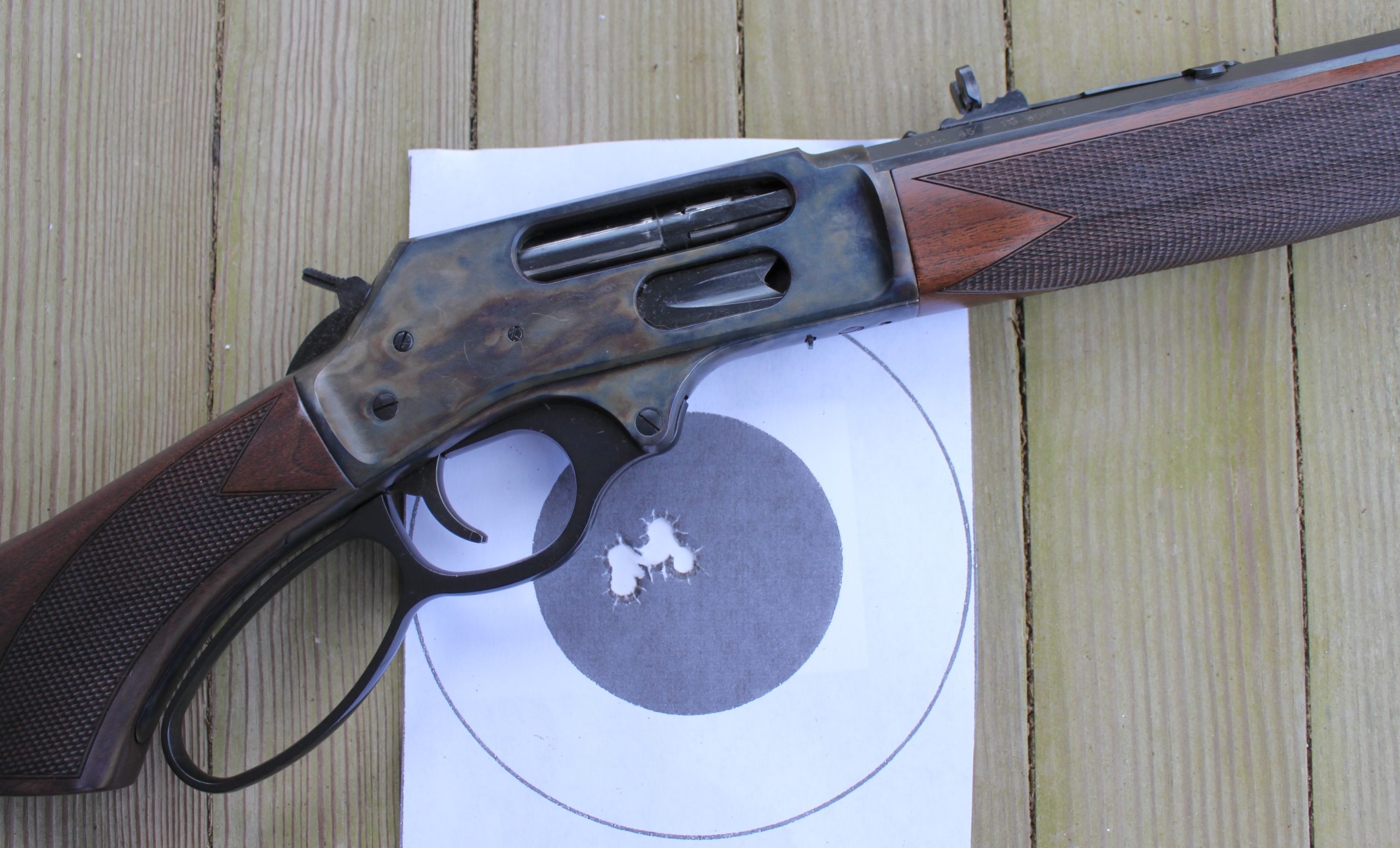
By Jim Dickson | Contributing Writer
Photos, artwork courtesy of Black Hills Ammunition, Aram Von Benedikt
Ever since it first came out in 1873 the .45-70 has been a favorite American hunting cartridge offering accuracy and killing power that was more than adequate for all North American big game.
Generations of American hunters have sworn by it and its popularity is growing today as more and more hunters discover it’s emphatic killing power on game. It is not surprising then that 21st Century advancements would be extended to this old reliable game killer.
Black Hills Ammunition has brought out their famed HoneyBadger bullet in a .45-70 load. This is a 325-grain monolithic fluted solid that leaves a 26-inch barrel at 1,933 FPS. The bullet is marked by deep flutes which are larger at the front and narrower at the back. When passing through flesh the blood and tissue is forced outwards along those flutes and they end up traveling 35 percent faster than the bullet itself because the large pressure differential between the large fluted regions and the free stream velocity. This tissue and fluid velocity of 2,610 FPS creates a cavitation passage far larger than the solid bullet yet because the bullet is not expanding it penetrates far deeper than a regular expanding bullet. You have the best of both worlds. A massive wound channel and deep penetration.
The Taylor Knock Out Values are 41.10 which is greater than the .375 H&H Magnum. This flat shooting .45-70 load would also be an excellent choice for non-dangerous African plains game.
This power and penetration was amply demonstrated on a buffalo hunt in the Henry Mountains of Utah where Aram Von Benedikt was going with his friend Dan, and Dan’s father. Dan had drawn a once in a lifetime permit to shoot a cow buffalo there. He was using a new Browning/Winchester Model 1886 with Black Hills HoneyBadger ammunition.
Dan had proven that he could keep all his shots on a 18 inch steel plate at 300 yards from a prone position using this rifle and ammunition. They set out on horseback and had been hunting four days 11 miles from the nearest gravel road when they came upon the herd one evening. Night fell before they could stalk close enough for a shot.
The next morning they tracked the herd for 2 to 3 miles before closing with them. The horses were then tied up and they began stalking through fairly thick pinyon and juniper timber. Stalking to within just under 200 yards Dan readied his shot. Just then the wind swirled, and the herd caught their scent spooking them. As the shot fired the cow began to turn resulting in the bullet going through her hindquarters before exiting.
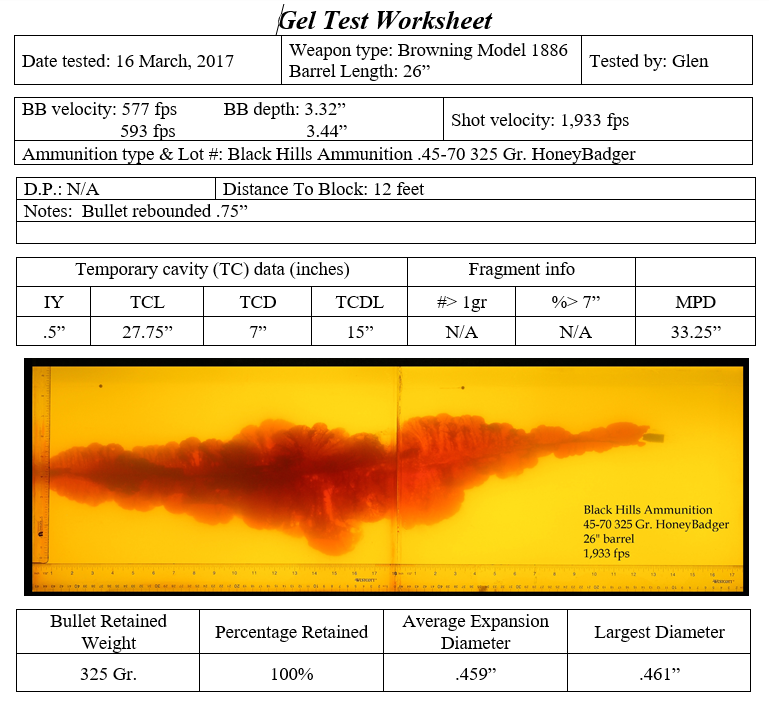
They began tracking, a job made more difficult by the herd scattering. Dan’s father was the one who found her lying down. She arose and shook her head angrily at him then ran off. He yelled at Dan that the buffalo was coming his way. Dan put four fast shots from his lever action into the brisket at about 15 yards. The animal ran about 35 yards and piled up dead. Her lungs were reduced to jelly and all four bullets had exited.
The first bullet of this sort was invented by Charles Kelsey. Years later Lehigh Defense came out with their “Extreme Penetrator” which had smaller, less aggressive flutes than the later HoneyBadger design.
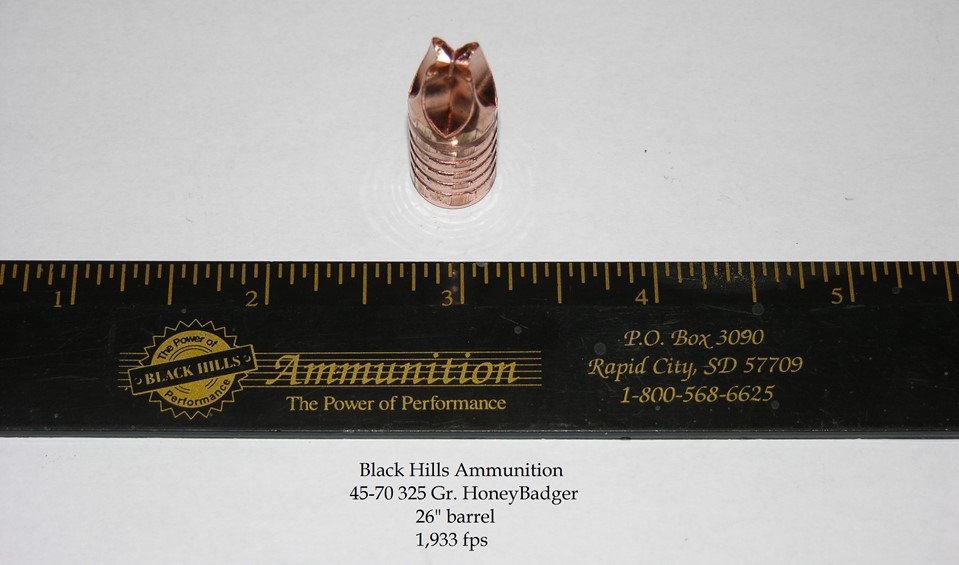
Lehigh Defense partnered with Jeff Hoffman at Black Hills Ammunition to continue development of the design. Jeff worked with Justin Evans of Lehigh Defense on this project. Later Justin came to work for Jeff at Black Hills Ammunition.
The design goal was to have the penetration of a FMJ round with the energy transfer of an expanding bullet. This was achieved by the use of large flutes in the bullet designed to give the optimum amount of drag for a given projectile weight, velocity, and shape allowing them to penetrate the desired distance. For the .45-70 this was 27.75 inches of ballistic gelatin.
The drag created by the flutes is what transmits the energy to the target as opposed to the bullet expanding in a conventional SP round. The HoneyBadger does this by forcing the fluid medium of blood and tissue along the paths of the flutes resulting in significant drag and energy transfer without the bullet changing shape. The freestream fluid (technically it is a static fluid that the projectile is moving through) encounters heavy resistance and stagnation once it encounters the meplat (the tip of the bullet). This causes the pressure to skyrocket. The fluid does not like being at such high pressure, so it hastens to move to areas of lesser pressure.
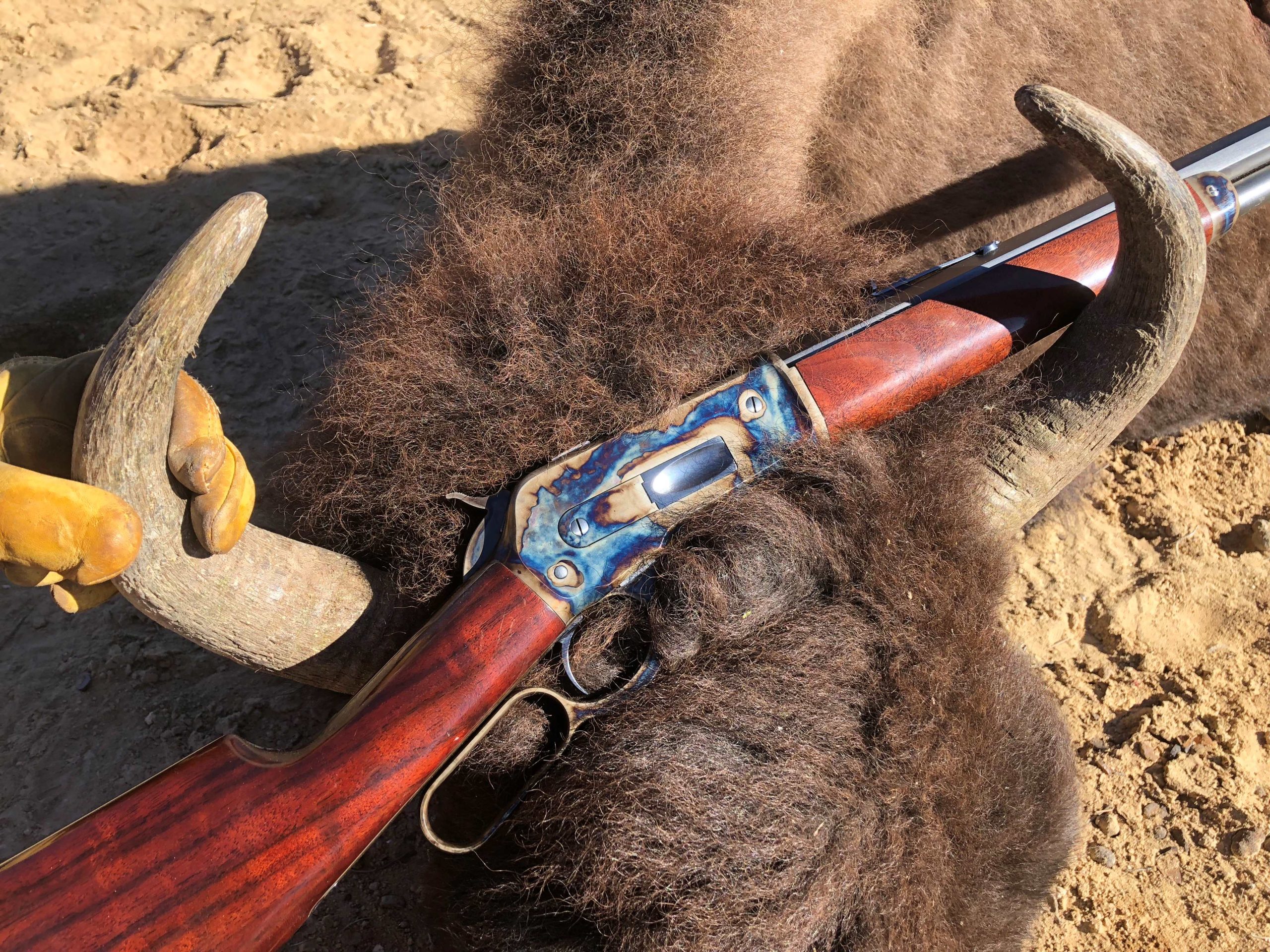
The HoneyBadger’s flutes are designed to encourage the fluid to move along their curved path. This extremely fast fluid movement and cavitation results in drag and transferal of energy by these fluid mechanisms taking hydrostatic shock effects to a new level.
It is similar to a snowplow forcing the snow in front of it out to the sides. The HoneyBadger forces the fluids and tissue in front of it away to the sides at a velocity far greater than the projectile itself creating a wide bullet channel. The best part is that it does this without changing shape which would drastically curtail penetration.
One of the original guys at Lehigh Defense said, “It doesn’t need to deform to perform!” Since it doesn’t mushroom the bullet will always punch through thick hide, muscle and bone to reach the vitals. When a bullet deforms it often also loses weight as pieces break off and its path may deviate through the target.
For example, in elephant hunting any bending or deformation of the FMJ bullet can lead to a critical loss of penetration and direction in the massive skull of the pachyderm. Only undeformed bullets can fully penetrate and exit. That lesson applies to smaller game as well and that is where the HoneyBadger shines.
Since the majority of .45-70 rifles made today are lever actions, the bullet was specifically designed for their needs. The .45-70 HoneyBadger has a joint patent between Jeff Hoffman of Black Hills Ammunition and Lehigh Defense where Jeff had the great idea to notch the nose of the bullet so that it could never hit the primer of the cartridge in front of it in the tubular magazine of a lever action rifle. Lehigh then created a notched meplat that did not hinder terminal performance and penetration yet insured that the nose of the cartridge rests only on the case head and never on the primer of the cartridge in front of it.
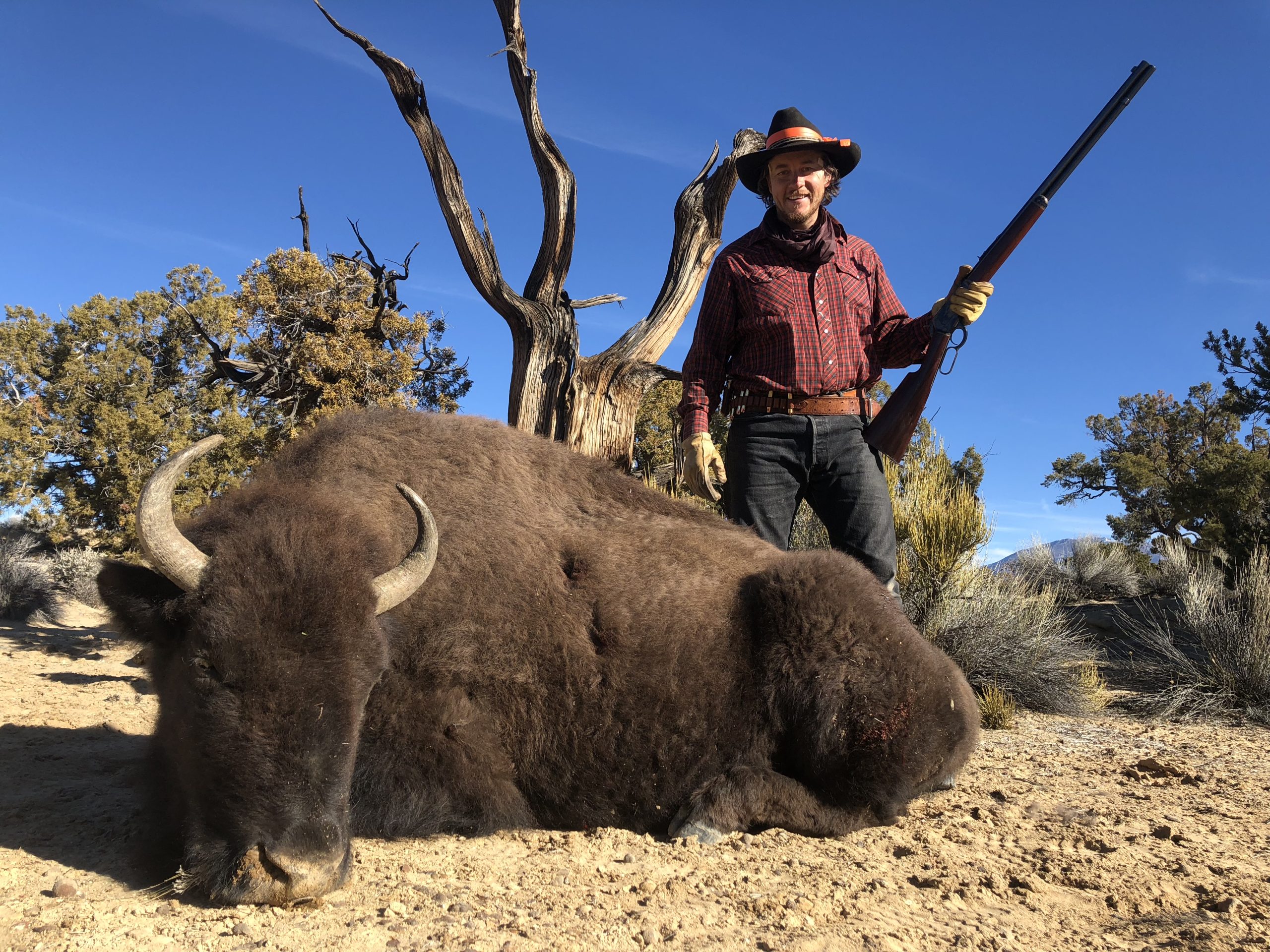
This notching of the bullet’s nose creates posts that dig into hard bone preventing deflection. Oddly shaped hard bone is particularly good at deflecting normal bullets. Contrary to what some writers have said, the .600 Nitro Express’s blunt bullet was not for stopping power but was designed so as not to deflect on the bone around an elephant’s temple. This happened on one of the largest elephants ever shot. The first .450-400 deflected off the rounded bone and it took a second shot that did not deflect to bring the great beast down.
There is a problem that trappers in the Alaskan interior sometimes face where the .45-70 HoneyBadger is called for. Snow covers some of the swiftly flowing streams in the winter leaving them quite undetectable in places despite the fact that water continues to flow unseen below. Step on one of these and you can easily break through and get soaked in the sub-zero cold. Sometimes a grizzly bear wakes up from his nap during hibernation and decides to take a stroll. If he falls through his coat ends up covered with sheets of hair-reinforced ice that pull on his hair and are cold. If you thought grizzlies could be bad tempered before you ain’t seen nuthin’ yet! People having to shoot an attacking iced up bear often find that the ice acts like armor inhibiting bullet penetration and performance. With an enraged grizzly in your face this is a very bad thing. The 45-70 HoneyBadger is an excellent choice for this situation as it does not deflect, break up, or fail to penetrate adequately as some bullets have under these extreme circumstances.
For a long time there were basically only two types of bullets from which to choose. Now there are three. The FMJ, the expanding soft point, and now the HoneyBadger which does a good job of combining the best features of both the FMJ and the SP in one bullet. As the newest member of this trio it’s time you got to know it and its capabilities.
I had 40 rounds of 45-70 HoneyBadger for test firing in my octagon barrel, steel frame Henry lever action. I found it accurate, reliable, and pleasant to shoot. This is a cartridge that I can highly recommend.

